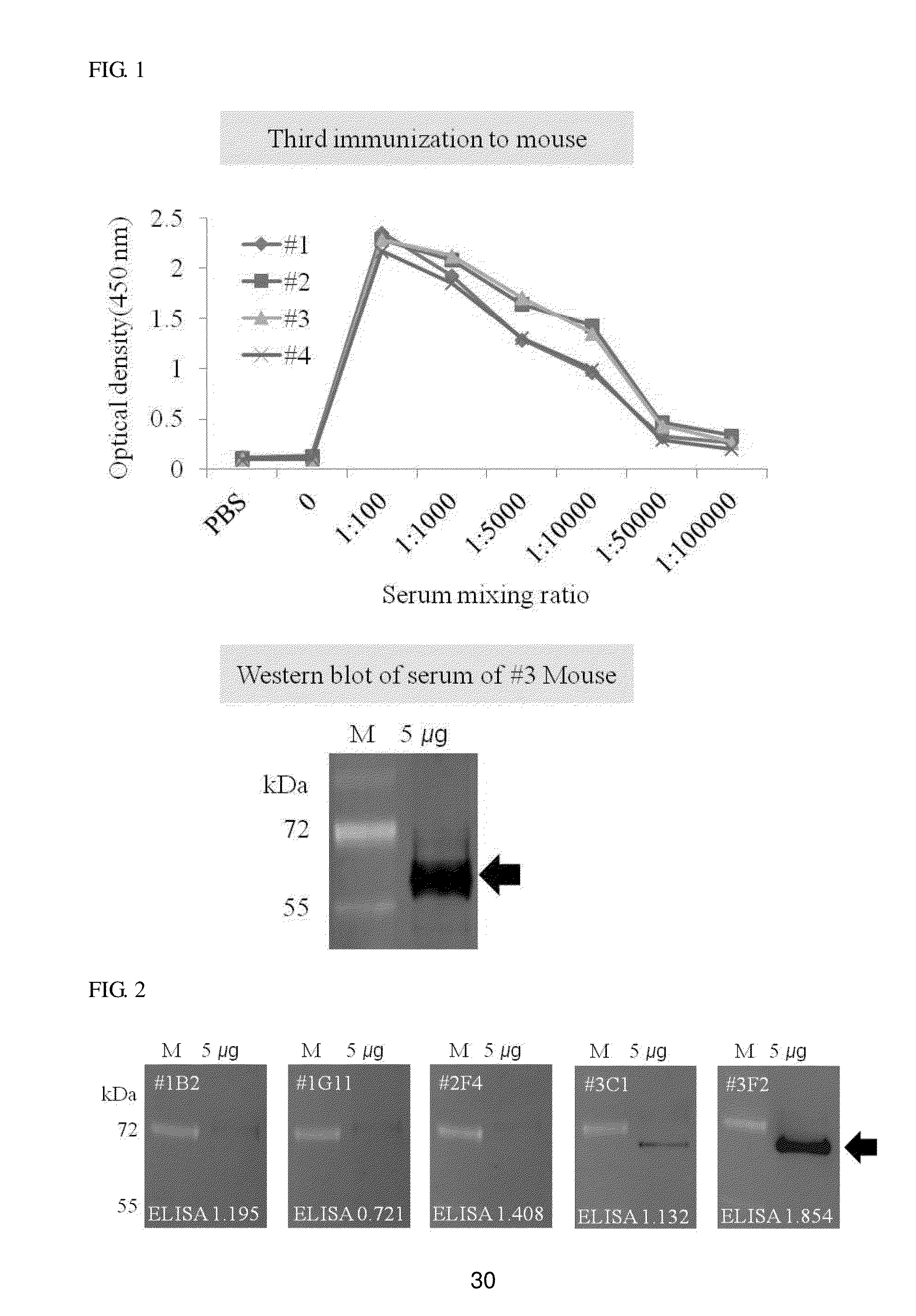Monoclonal Antibodies which Specifically Recognize Human Liver-Carboxylesterase 1, Hybridoma Cell Lines which Produce Monoclonal Antibodies, and Uses Thereof
- Summary
- Abstract
- Description
- Claims
- Application Information
AI Technical Summary
Benefits of technology
Problems solved by technology
Method used
Image
Examples
example 1
Supply of Liver Tissue and Plasma Samples
[0067]50 mg of liver tissues were put into a cell lysis RIPA buffer [50 mM Tris, 150 mM sodium chloride (NaCl), 1% NonidetP-40, 0.25% sodium deoxycholate, pH 7.4] to be disrupted at 4° C. under a refrigeration condition, and centrifuged at 14000 rpm for 20 minutes to recover a protein solution.
[0068]Plasmas dispensed from normal persons, hepatitis patients, cirrhosis patients, and liver cancer patients whose pathological respective data were ensured were provided from the gene bank of Severance Hospital. As the plasmas of the normal persons, samples determined to be negative from liver cancer standard test factors, such as HIV-1 and HIV-2 antibodies derived from human immunodeficiency virus (HIV), a HIV-1 antigen, a hepatitis B surface antigen, a hepatitis B core antigen, a hepatitis C virus, a T cell leukemia virus (HTLV-I / II) antigen, and a Treponema palladium test, were used, and stored at −70° C. before the test. The supply of the plasma ...
example 2
Selection of Optimal Antigen Determinant
[0069]The selection of a peptide having an optimal antigen determinant in a three-dimensional structure of the liver-carboxylesterase 1 was analyzed using software produced from AbFrontier, and from the analyzed peptide list, it was confirmed that the selected peptide was different from an amino acid sequence of a corresponding protein of a mouse to be immunized. Finally, a peptide having 13 amino acid sequences was synthesized by performing analysis in an actual research and reselection based on a peptide specific to the liver-carboxylesterase 1 (refer to Table 1).
TABLE 1Amino acidLocation ofSpeciessequence(n)amino acidHumanKAVEKPPQTEHIEL13554-567MouseLRAKKPPQTGHTEL13554-567
example 3
Immunization of Mouse
[0070]In each peptide group, the same amount of auxiliary antigens (Freund's adjuvants) were emulsified to be primarily injected into the abdominal cavity of each of four female BALB / c mice, and after 4 weeks, secondary injection was performed, and after 2 weeks, third injection was performed again to immunize the mouse.
[0071]A serum was isolated from the tail of each mouse before each injection, and then a degree of reaction between a peptide antigen and an antibody produced from the mouse was measured by enzyme immunoassay.
[0072]Western blotting was performed together to perform analysis at a protein level. Measurement of bindability with the liver-carboxylesterase 1 protein was performed by the western blotting, and as a standard sample, a liver tissue protein was used.
[0073]5 μg of a liver tissue protein quantified and added was isolated through 10% SDS-PAGE, and the gel was transferred to a nitrocellulose (NC) membrane and then blocked with a TBS-T buffer c...
PUM
| Property | Measurement | Unit |
|---|---|---|
| Concentration | aaaaa | aaaaa |
Abstract
Description
Claims
Application Information
 Login to View More
Login to View More - R&D
- Intellectual Property
- Life Sciences
- Materials
- Tech Scout
- Unparalleled Data Quality
- Higher Quality Content
- 60% Fewer Hallucinations
Browse by: Latest US Patents, China's latest patents, Technical Efficacy Thesaurus, Application Domain, Technology Topic, Popular Technical Reports.
© 2025 PatSnap. All rights reserved.Legal|Privacy policy|Modern Slavery Act Transparency Statement|Sitemap|About US| Contact US: help@patsnap.com



